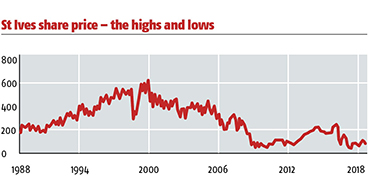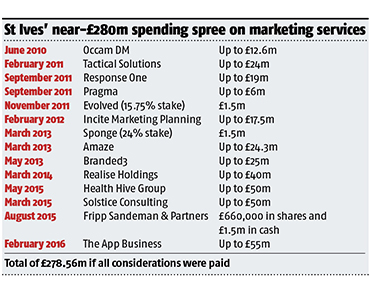The sale earlier this month of its last vestige of a printing operation – print management wing SIMS – to Paragon marked the exit from our industry of a once-mighty business that grew and grew out of a booming printing industry and savvy management.
The chief architect of that past success being, of course, its legendary founder the late Bob Gavron, who subsequently became Lord Gavron after he stepped down from the company he founded.
Those who worked there when the group was in its printing pomp will never forget the experience.
“It really was a heyday,” says Astron founder David Mitchell, who landed his first role at St Ives by writing to Gavron with a copy of his CV and a letter saying “you need me”.
“It was, I think, and really felt like the world’s best printing company at the time. It was the best company and you were working with the best people. Suppliers really wanted to deal with you and as a young manager it was great for the self-esteem,” he recalls.
And while Gavron was undoubtedly an exceptional and exceptionally charismatic leader, there were many other talents at the group beyond the chairman.
“There were lots of others too, and they were probably there because of him [Gavron]. It became a virtuous circle,” Mitchell adds.
“My first bosses at St Ives were Ken Pardey and Peter Stafford, they and Peter Livermore (web sales director) were legends to me and giants of their time. Ken taught me the benefits of team working, Peter Livermore showed me what style looked like and Peter Stafford could turn a customer problem around within five minutes.
“Bob Gavron – and Brian Edwards let’s not forget his important role – empowered me and others with freedom to innovate and allow entrepreneurism, to express, make mistakes and to be successful. I was in my 20s and Bob asked me to visit Dainippon Screen in Kyoto. We came back with better ways to use a step-and-repeat machine for producing multiple and different CD booklets, which then transformed our profitability and customer responsiveness.”
Gavron floated the business in 1985, to gain the capital needed for his ambitious expansion plans, a move that wouldn’t have been necessary in more recent times given the options available via private equity, believes Brian Edwards, who was the group’s finance director, managing director, and then chief executive from 2007-2009.
Those boom years of magazine, financial and multimedia printing paid handsome dividends for St Ives shareholders and its employees.

And the group’s continual reinvestment in the latest technology was also great news for the company’s suppliers in an era when it was typically spending many millions of pounds a year on new kit.
“It was the gold standard of running a printing business, with good solid business principles,” says John Charnock, the group’s former technical director who spent 18 years working at the PLC.
But, as our boxout shows, even in what can now be viewed as halcyon days the path of acquiring and integrating businesses – especially perhaps overseas acquisitions – was sometimes a rocky road. St Ives’ expansion into the US and continental Europe printing markets ultimately resulted in the group retrenching back to its UK roots.
And fundamental changes in some of its main customer sectors also put a crimp in previously stellar profits. Mitchell points to the deregulation of the TV listings market in 1991 as being a key turning point, and since then the financial printing market has also dwindled to a shadow of its former self, followed by the magazine market where St Ives was competing head-on with BPC and then Polestar, with business plans that involved attempting to pay off sky-high interest charges at pretty much all costs.
“Sad to say it, but the whole smearing ink on dead trees sector became really un-fancied by investors and the city and commoditised and de-valued by the customers over the last 30 years,” he says.
It’s also worth pausing for thought to consider what might have been. Tangent Communications caused a sharp intake of breath when the comparative minnow was revealed as the mystery bidder behind an approach to take over the PLC back in 2006. The Tangent bid would have been worth around 272.5p a share, valuing the group at around £272m.
Mitchell says he also had ambitions to acquire the business himself “on more than one occasion” including a proposal to offer £2.50 a share in 2007 when the share price was around £2. His overtures were rejected by one of the group’s major shareholders at the time.
Meanwhile, throughout all of these changes in market dynamics perhaps the one constant was an ever-reliable source of cash and profits at venerable book printing wing, Clays. It’s hard to see how the expensive reinvention of St Ives as a marketing services business could have happened without it.
This repositioning of St Ives as a marketing business began under then chief executive Patrick Martell in 2010 with the purchase of data marketing business Occam.
A dozen more deals followed, with new chief executive (and former CFO) Matt Armitage picking up the marketing M&A baton after Martell departed for pastures new in 2014.
The near-£280m deal spree culminated in St Ives’ most expensive marketing buy yet, the £55m deal to acquire The App Business in February 2016. This required a rights issue to raise £13.8m at 215p a share and the taking on of an additional £10m of debt. The wheels came off just two months later when the group issued a profits warning for the 2016 and 2017 financial years, causing its share price to tank and marking the beginning of the end for the business in print.
By March 2017 the PLC had effectively hoisted a ‘for sale’ sign over its remaining printing businesses. With one of the ironies of the situation being that, while St Ives has been viewed as acquiring marketing businesses with prices that reflect the top of the market, its exit from print has resulted in some bargains being snapped up elsewhere.
Walstead Group, whose chief executive Paul Utting was web sales director at St Ives earlier in his career, acquired its web division for £20m in 2011. More recently the acquisitive Paragon Group acquired the profitable, £49.5m turnover SIMS print management wing for just £11m.
It is perhaps ironic that both of these groups now have sales heading north of the €700m mark, and are closer to being billion-turnover businesses than St Ives ever was, whereas St Ives itself is now looking rather small to be a PLC.
What next, then, for St Ives? At the time of writing the group’s share price was 95.6p and it had a market capitalisation of £144.5m. Its remaining marketing businesses posted sales of £163m in its most recent results.
As of next month, the firm will have a new chief executive in the shape of J Schwan, the founder of another St Ives buy, Solstice. And for those who view the marketing services business as having something of the emperor’s new clothes about them, the future attire of St Ives’ results will still be of interest. There is, now, nowhere to hide when it comes to the marketing services play. There are no ‘legacy’ print businesses to blame for any underperformance.
And for those in the printing industry that once looked up to this business as something to aspire to, it can only be hoped that some of Gavron’s original business genius, which so obviously rubbed off on those who worked directly with him, can be perpetuated in print among those who worked for them. In which case ‘legacy’ will not be considered a dirty word.
St Ives timeline
1964 St Ives founded by Bob Gavron
1983 Acquires Severn Valley Press in Caerphilly, St Ives Web launched
1985 Floats on the stock market
1986 Acquires book printer Clays
1987 Acquires financial printer Burrups
1989 Acquires AD Weiss Printing in the US
1993 Gavron steps down
1995 Acquires Johler Druck
1998 Acquires Hunters Armley, which becomes St Ives Direct. Gavron sells his last chunk of shares in the group
1999 Gavron is made a Labour peer
2000 Acquires Packard Press
2001 Acquires Avanti Press and Case-Hoyt
2004 Acquires SP Group, closes Case-Hoyt in US
2005 Sells loss-making German business Johler Druck
2006 Launches print management wing SIMS, acquires Service Graphics. Tangent Communications makes £282m bid to buy St Ives
2008 Sells Netherlands multimedia facility
2009 Sells US web business to MBO team
2010 First marketing services buy – Occam in £12.6m deal
2011 Wyndeham Group owner Walstead buys web division for £20m
2013 Sells St Ives Direct Bradford to Cogent B2B
2015 Lord Gavron dies, aged 84
2017 Second profits warning in nine months trashes share price. Remaining print operations put up for sale
2018 SP Group and Service Graphics sold to SelmerBridge; Clays sold to Elcograf, SIMS sold to Paragon. CEO Matt Armitage resigns












